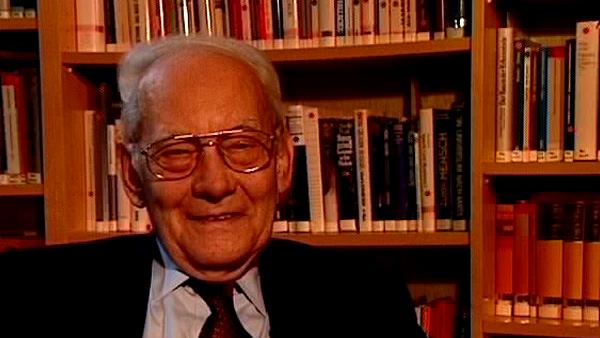NEXT STORY

Rudolf Rigler: looking at fluctuations
RELATED STORIES

NEXT STORY

Rudolf Rigler: looking at fluctuations
RELATED STORIES


|
Views | Duration | |
|---|---|---|---|
| 71. Renormalisation and stochastic theory | 149 | 03:48 | |
| 72. Evolution is a quick process whenever the conditions are good | 107 | 01:29 | |
| 73. David Blow's work on the structure of a pancreatic enzyme | 101 | 03:35 | |
| 74. Subtilisin had exactly the same proton relay | 92 | 01:50 | |
| 75. Lerner and Schultz – making catalysts from antibodies | 113 | 03:49 | |
| 76. The evolution of viruses | 126 | 02:11 | |
| 77. Evolutionary technology | 103 | 04:18 | |
| 78. The PCR method | 112 | 03:57 | |
| 79. The 3SR method | 100 | 04:05 | |
| 80. The serial transfer experiment with more than one sample | 95 | 02:53 |


I had described the serial transfer experiment with one sample. Now of course... why taking only one sample? We take a foil and make ninety-six, a microtiter plate, it has ninety-six samples. And these can be handled by the amplification techniques. Now we have three metal blocks with the three different temperatures and we move it from block to block so we can... we don't need Q-beta enzyme any more, we can amplify with the method and we can watch again with a fluorescence or some glass fibre optics to it... now ninety-six parallel channels. And, you know, when you start this the students become inventive. Meanwhile we have 960-channel method there. That means already our glass fibre optics are about 3km of glass fibres, but you see a real technology is coming out of it.
[Q] Big, large technology.
Big technology, and that's what we had in mind from the beginning. As I say, many people now do work on evolutionary biotechnology, but it's a more pedestrian type of work than...
[Q] On a smaller scale.
Yes, on a smaller scale. And once you are at a 1000-channel machine you're starting to think how could you improve that to 100,000 or a million, which means you get into nanotechnology. You get into sampling very small sample amounts, which means size of microlitre or so. And that, of course, requires a very new technology, and this is really our present main job, to develop suitable methods for this nanotechnology. What are the problems? You could say also: where are the limits? Well, the limit is to detect a single molecule. And this idea, can we get down to single molecules, I had about a few years ago, and then I was remembering that one previous co-worker, a post-doc of mine, really meanwhile had pioneered a technology which was suitable for doing such studies. And I must tell a little bit more about that because it's our present main experimental work we are doing.
Nobel Prize winning German biophysical chemist, Manfred Eigen (1927-2019), was best known for his work on fast chemical reactions and his development of ways to accurately measure these reactions down to the nearest billionth of a second. He published over 100 papers with topics ranging from hydrogen bridges of nucleic acids to the storage of information in the central nervous system.
Title: The serial transfer experiment with more than one sample
Listeners: Ruthild Winkler-Oswatitch
Ruthild Winkler-Oswatitsch is the eldest daughter of the Austrian physicist Klaus Osatitsch, an internationally renowned expert in gas dynamics, and his wife Hedwig Oswatitsch-Klabinus. She was born in the German university town of Göttingen where her father worked at the Kaiser Wilhelm Institute of Aerodynamics under Ludwig Prandtl. After World War II she was educated in Stockholm, Sweden, where her father was then a research scientist and lecturer at the Royal Institute of Technology.
In 1961 Ruthild Winkler-Oswatitsch enrolled in Chemistry at the Technical University of Vienna where she received her PhD in 1969 with a dissertation on "Fast complex reactions of alkali ions with biological membrane carriers". The experimental work for her thesis was carried out at the Max Planck Institute for Physical Chemistry in Göttingen under Manfred Eigen.
From 1971 to the present Ruthild Winkler-Oswatitsch has been working as a research scientist at the Max Planck Institute in Göttingen in the Department of Chemical Kinetics which is headed by Manfred Eigen. Her interest was first focused on an application of relaxation techniques to the study of fast biological reactions. Thereafter, she engaged in theoretical studies on molecular evolution and developed game models for representing the underlying chemical proceses. Together with Manfred Eigen she wrote the widely noted book, "Laws of the Game" (Alfred A. Knopf Inc. 1981 and Princeton University Press, 1993). Her more recent studies were concerned with comparative sequence analysis of nucleic acids in order to find out the age of the genetic code and the time course of the early evolution of life. For the last decade she has been successfully establishing industrial applications in the field of evolutionary biotechnology.
Tags: serial transfer experiment, Q-beta enzyme, amplification techniques, evolutionary biotechnology, nanotechnology
Duration: 2 minutes, 54 seconds
Date story recorded: July 1997
Date story went live: 24 January 2008